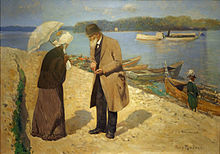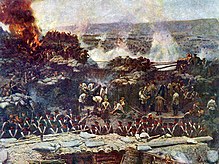Franz Roubaud
Franz Roubaud ( Ukrainian Франц Олексійович Рубо Franz Rubo Oleksiyovych , Russian Франц Алексеевич Рубо Franz Alekseevich Rubo , scientific. Transliteration Franc Alekseevic Rubo * 5; jul. / 17th June 1856 greg. In Odessa , Ukraine on the Black Sea, † March 11 1928 in Munich ; also François Iwan Roubaud or Frants Roubaud ) was a Russian painter . Roubaud became known as a battle painter and with pictures from the life of the Caucasus.
Life
Franz Roubaud was the third of nine children of the merchant Alexis Roubaud, who had emigrated from Marseille , and Madeleine Sénèque, a tailor from Clermont-Ferrand .
He began his first drawing studies at the age of six, followed by study visits to the Caucasus . From 1865 to 1877 he studied at the drawing school in Odessa, 1877/1878 he studied with Carl Theodor von Piloty , Otto Seitz and Wilhelm von Diez in Munich, then also with the soldier painter Joseph von Brandt . In 1883 and 1884 he toured parts of the Caucasus on behalf of the Russian government , including Yerevan and Tbilisi , Baku on the Caspian Sea, and Bukhara and Tashkent in West Turkestan. In 1885 he was commissioned to produce a 17-part picture cycle for the Hall of Fame in Tbilisi. In the following year, accompanied by college friends Rudolf Otto von Ottenfeld , Johannes Leonhard (1858–1913) and Robert Büchtger (1862–1951), who was born in Russia, he again traveled to the Caucasus. In 1889 he received the title of nobility and was by the Tsar Alexander III. and Nicholas II especially encouraged. In 1895 he received a small gold medal at the Great Berlin Art Exhibition . Stays in Paris and Saint Petersburg followed . There he was a professor at the art academy from 1903 to 1912. With this interruption, the painter lived in Munich and Rimsting am Chiemsee, where he had acquired a property in 1903. When the First World War broke out, he escaped internment as a Russian citizen only by taking on German citizenship. His grave is in the Frauenchiemsee cemetery . The Neue Münchner Galerie in Residenzstrasse honored the artist in 1928 with a comprehensive exhibition of his works.
Works
Three panoramas and the battle paintings on Russian history related to other historical events make up the main work of the painter. In addition, numerous compositions were created from the Caucasus and the Asian regions of Russia, such as hunting and market scenes, a caravan rest and others. However, the number of sketchy and executed representations of mounted fighters of the Caucasian mountain peoples (Roubaud traveled to Chechnya and Dagestan , but not the Circassian region ), who - probably because of their clothing with the "Cherkesska" and a fur hat typical of the entire Caucasus - is unmanageable as "Circassians", less often as "Cossacks". The best-known work is the 100-meter-long panorama painting The Siege of Sevastopol (1904), for which a separate museum was built in Sevastopol . Other panoramic paintings are the Battle of Borodino (1912; exhibited in the Moscow Panorama Museum of the Battle of Borodino since 1962 ) and the storming of the Auls Achulgo in September 1839 , 1889/90 in Munich.
literature
- Hans-Peter Bühler: Hunters, Cossacks and Polish Horsemen. Hildesheim u. a. 1993.
- Claudia Over in: Trödler & Collector Journal . October 2004, pp. 56–61 (with 16 color paintings).
- Siegfried Weiß : Wilde Caucasians (Die Tscherkessenreiter of Franz Roubaud) , in: Weltkunst, Issue 7, July 2005, pp. 70–71.
- Franz Schiermeier: Panorama Munich. Illusion and reality. Munich as the center of panorama production. Munich 2009, pp. 79, 82, 101.
- Olga Sugrobova-Roth and Eckart Lingenauber: Franz Roubaud Catalog Raisonné - catalog raisonné . Cologne, Vam Ham Art Publications 2013 (German / Russian).
Web links
Individual evidence
- ↑ Gerd Otto-Rieke: Graves in Bavaria . Munich 2000, p. 112.
- ↑ The panorama, produced with the assistance of Leopold Schönchen (1855–1935), Heinrich Merté (1838–1917) and others, was built by the architects O. Enberg and W. Feldman under the supervision of Roubaud in Sevastopol and opened on May 14, 1905. It shows the defense of Malachov Hill on May 18, 1855 against the onslaught of French and British troops. Destroyed by the German Air Force in 1942, the restored panorama was reopened in 1954 on the 100th anniversary of the city's defense
- ↑ The 15 meter high and 115 meter long painting was carried out with the support of colleagues from Munich, Jan Rosen , Hans von Bartels and others
| personal data | |
|---|---|
| SURNAME | Roubaud, Franz |
| ALTERNATIVE NAMES | Рубо, Франц Алексеевич (Russian); Rubo, Franz Aleksejewitsch; Rubo, Franc Alekseevič (scientific transliteration); Roubaud, François Iwan; Roubaud, Frants |
| BRIEF DESCRIPTION | Russian painter |
| DATE OF BIRTH | June 17, 1856 |
| PLACE OF BIRTH | Odessa |
| DATE OF DEATH | March 11, 1928 |
| Place of death | Munich |



